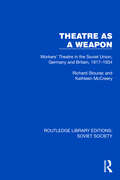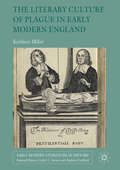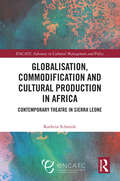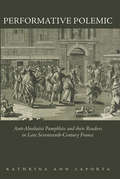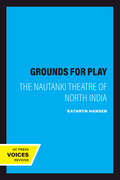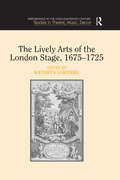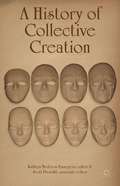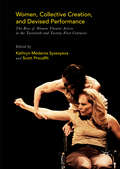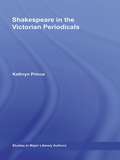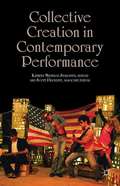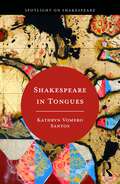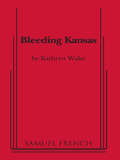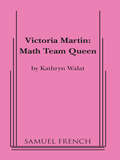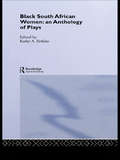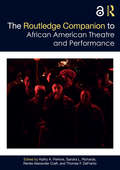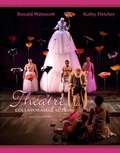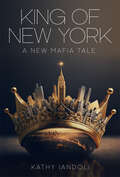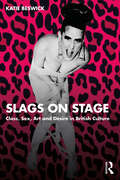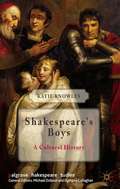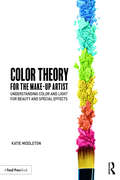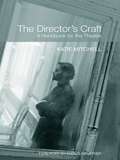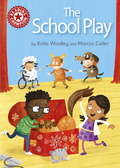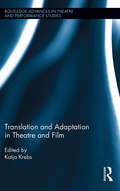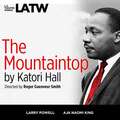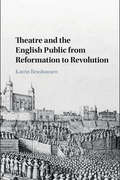- Table View
- List View
Theatre as a Weapon: Workers' Theatre in the Soviet Union, Germany and Britain, 1917–1934 (Routledge Library Editions: Soviet Society)
by Richard Stourac Kathleen McCreeryBased on theatrical research of unusual depth and enterprise, Theatre as a Weapon (1986) shows how the workers’ theatre of the 1920s and 1930s transformed the social function of theatre. Drawing largely on unpublished sources, it provides lively case studies of workers’ theatre in the USSR, Germany and the United Kingdom. They range from the Russian mass spectacles in front of the Winter Palace, through the thousands of factory and courtyard performances in Germany, to the May Day activities of the Workers’ Theatre Movement all over Britain. The authors worked for many years in political theatre in Britain, Austria and Germany, and they draw on their wide experience to focus on both major theoretical controversies and their practical ramifications. They show how workers’ theatre became an instrument, a weapon, for political change, helping to raise the consciousness of thousands of workers and encouraging them to take action. They describe how worker-actors, musicians, writers and directors formed small, flexible troupes which contributed locally to the day-to-day struggles of their class, while at the same time participating in national and international political campaigns. Developments in dramatic structure are analysed, from the simple review form to the more complex scene-and-song montage. Placing the work of Meyerhold, Eisenstein, Piscator, Brecht and Eisler in this context, the authors demonstrate how the montage principle became the significant factor in the political theatre of this period. The book is illustrated with rare photographs which reflect the atmosphere of those mass movements. Unique in its coverage, Theatre as a Weapon is above all an analysis of how the mirror of realistic theatre was transformed into a dynamic weapon for social change. It fills an important gap in the history of working-class culture.
The Literary Culture of Plague in Early Modern England
by Kathleen MillerThis book is about the literary culture that emerged during and in the aftermath of the Great Plague of London (1665). Textual transmission impacted upon and simultaneously was impacted by the events of the plague. This book examines the role of print and manuscript cultures on representations of the disease through micro-histories and case studies of writing from that time, interpreting the place of these media and the construction of authorship during the outbreak. The macabre history of plague in early modern England largely ended with the Great Plague of London, and the miscellany of plague writings that responded to the epidemic forms the subject of this book.
Globalisation, Commodification and Cultural Production in Africa: Contemporary Theatre in Sierra Leone (ENCATC Advances in Cultural Management and Policy)
by Kathrin SchmidtThis book engages with contemporary cultural production in Africa, focusing on theatre in Sierra Leone as main case study. The author provides coverage of, and insights into, such themes as cultural globalisation, commodification, the global creative economy, culture and development, international relations and contemporary cultural production in Sierra Leone within the context of local and global flows of people, media, images, technologies, finance and ideas. Combining the analysis of theatre in Sierra Leone and its aesthetics with its policy, structural and institutional context, this book highlights in much detail and nuance the interconnectedness between the micro- and the macro-levels of cultural production, between the local and the global, and between aesthetics, politics, policy, governance structures and institutions. This book links the particular findings from the author’s fieldwork to larger issues of contemporary local cultural production within the context of globalisation, commodification and decolonisation; adds a postcolonial perspective to existing theories and approaches to cultural production, management and policy, which is still largely missing from the existing discourse; and also contributes to addressing the gap in the knowledge about the context of contemporary cultural productions in diverse African contexts. This book will be particularly useful for both theatre scholars with an interest in the political economy of theatre and, more broadly, those seeking to understand the nuanced challenges and opportunities faced by policymakers, artists and arts managers to embrace the cultural and creative industries in this context. It also offers excellent insights for policymakers who wish to improve their understanding and interventions beyond superficial ‘best practice’ snippets and simplified ‘success stories’.
Performative Polemic: Anti-Absolutist Pamphlets and their Readers in Late Seventeenth-Century France (The Early Modern Exchange)
by Kathrina Ann LaPortaPerformative Polemic is the first literary historical study to analyze the “war of words” unleashed in the pamphlets denouncing Louis XIV’s absolute monarchy between 1667 and 1715. As conflict erupted between the French ruler and his political enemies, pamphlet writers across Europe penned scathing assaults on the his bellicose impulses and expansionist policies. This book investigates how pamphlet writers challenged the monarchy’s monopoly over the performance of sovereignty by contesting the very mechanisms through which the crown legitimized its authority at home and abroad. Author Kathrina LaPorta offers a new conceptual framework for reading pamphlets as political interventions, asserting that an analysis of the pamphlet’s form is crucial to understanding how pamphleteers seduced readers by capitalizing on existing markets in literature, legal writing, and journalism. Pamphlet writers appealed to the theater-going public that would have been attending plays by Molière and Racine, as well as to readers of historical novels and periodicals. Pamphleteers entertained readers as they attacked the performative circuitry behind the curtain of monarchy.
Grounds for Play: The Nautanki Theatre of North India
by Kathryn HansenThe nautanki performances of northern India entertain their audiences with often ribald and profane stories. Rooted in the peasant society of pre-modern India, this theater vibrates with lively dancing, pulsating drumbeats, and full-throated singing. In Grounds for Play, Kathryn Hansen draws on field research to describe the different elements of nautanki performance: music, dance, poetry, popular story lines, and written texts. She traces the social history of the form and explores the play of meanings within nautanki narratives, focusing on the ways important social issues such as political authority, community identity, and gender differences are represented in these narratives.Unlike other styles of Indian theater, the nautanki does not draw on the pan-Indian religious epics such as the Ramayana or the Mahabharata for its subjects. Indeed, their storylines tend to center on the vicissitudes of stranded heroines in the throes of melodramatic romance. Whereas nautanki performers were once much in demand, live performances now are rare and nautanki increasingly reaches its audiences through electronic media—records, cassettes, films, television. In spite of this change, the theater form still functions as an effective conduit in the cultural flow that connects urban centers and the hinterland in an ongoing process of exchange.
The Lively Arts of the London Stage, 1675–1725 (Performance in the Long Eighteenth Century: Studies in Theatre, Music, Dance)
by Kathryn LowerreUnlike collections of essays which focus on a single century or whose authors are drawn from a single discipline, this collection reflects the myriad performance options available to London audiences, offering readers a composite portrait of the music, drama, and dance productions that characterized this rich period. Just as the performing arts were deeply interrelated, the essays presented here, by scholars from a range of fields, engage in dialogue with others in the volume. The opening section examines a famous series of 1701 performances based on the competition between composers to set William Congreve's masque The Judgment of Paris to music. The essays in the central section (the 'mainpiece') showcase performers and productions on the London stage from a variety of perspectives, including English 'tastes' in art and music, the use of dance, the depiction of madness and masculinity in both spoken and musical performances, and genres and modes in the context of contemporary criticism and theatrical practice. A brief afterpiece looks at comic pieces in relation to satire, parody and homage. By bringing together work by scholars of music, dance, and drama, this cross-disciplinary collection illuminates the interconnecting strands that shaped a vibrant theatrical world.
A History of Collective Creation
by Kathryn Mederos Syssoyeva Scott ProudfitCollective creation - the practice of collaboratively devising works of performance - rose to prominence not simply as a performance making method, but as an institutional model. By examining theatre practices in Europe and North America, this book explores collective creation's roots in the theatrical experiments of the early twentieth century.
Women, Collective Creation, and Devised Performance
by Kathryn Mederos Syssoyeva Scott ProudfitThis book explores therole and centrality of women in the development of collaborative theatrepractice, alongside the significance of collective creation and devising in thedevelopment of the modern theatre. Tracing a web of women theatremakers in Europeand North America, this book explores the connections between early twentiethcentury collective theatre practices such as workers theatre and the dramaticplay movement, and the subsequent spread of theatrical devising. Chaptersinvestigate the work of the Settlement Houses, total theatre in 1920s' France,the mid-century avant-garde and New Left collectives, the nomadic performancesof Europe's transnational theatre troupes, street-theatre protests, andcontemporary devising. In so doing, the book further elucidates a history of moderntheatre begun in A History of CollectiveCreation (2013) and CollectiveCreation in Contemporary Performance (2013), in which the seeminglymarginal and disparate practices of collective creation and devising arerevealed as central--and women theatremakers revealed as progenitors of thesepractices.
Shakespeare in the Victorian Periodicals (Studies in Major Literary Authors)
by Kathryn PrinceBased on extensive archival research, Shakespeare in the Victorian Periodicals offers an entirely new perspective on popular Shakespeare reception by focusing on articles published in Victorian periodicals. Shakespeare had already reached the apex of British culture in the previous century, becoming the national poet of the middle and upper classes, but during the Victorian era he was embraced by more marginal groups. If Shakespeare was sometimes employed as an instrument of enculturation, imposed on these groups, he was also used by them to resist this cultural hegemony.
Collective Creation in Contemporary Performance
by Kathryn SyssoyevaThis edited volume situates its contemporary practice in the tradition which emerged at the beginning of the twentieth century. Collective Creation in Contemporary Performance examines collective and devised theatre practices internationally and demonstrates the prevalence, breadth, and significance of modern collective creation.
Shakespeare in Tongues (Spotlight on Shakespeare)
by Kathryn Vomero SantosShakespeare in Tongues interrogates the popular conflation of “the language of Shakespeare” with English by examining the role Shakespeare’s works have played in overlapping histories of colonialism, slavery, and migration that continue to shape the linguistic cultures of the United States.Opening up urgent and overdue conversations about linguistic oppression, racism, and resistance within the settler colonial nation-state, Kathryn Vomero Santos draws our attention to artists, activists, and educators who have conjured, embraced, remade, and rejected Shakespeare in service of multilingual counternarratives that push back against dominant perspectives, refuse assimilation, and strive for more polyglot and polyvocal futures. As they shine a bright light on the legacies of the federal Indian boarding school system, Indigenous language revitalization efforts, the militarization of the U.S.–Mexico border, and battles over ethnic studies in classrooms, these critical and creative engagements with Shakespeare offer powerful examples of how his works might be used to facilitate a more truthful understanding of the past and to identify restorative paths forward.Shakespeare in Tongues issues an imperative to redirect the material and intellectual resources that have been devoted to Shakespeare and his language toward truth, justice, and healing. This is essential reading for anyone studying or researching Shakespeare, race, translation, adaptation, and comparative literatures.
Bleeding Kansas
by Kathryn WalatHistorical DramaCharacters: 3 male, 2 femaleIt's 1855, Kansas Territory. The country is divided. People are turning against their neighbors because of their beliefs. War is on the horizon. Good people will do bad things and love will grow in places it shouldn't. A provocative, funny and insightful play revisits a crucial moment in American history. Homesteading farmers George and Kitty fight the elements to start a new life as a politically divided country takes a dangerous step towards civil war."To Walat's credit, her fast-moving play does not preach, merely raises questions, among them: Who are we as a nation? What shaped us and why? And does what we were-violent, intractable and destructive-play into our present-day society?...Bleeding Kansas is an excellent work" -San Diego News
Victoria Martin: Math Team Queen
by Kathryn WalatFull Length, Comedy Charaters 4 male, 1 female . Unit Set . When uber-popular Vickie Martin joins the all-male math team, chaos theory becomes the rule at Longwood High School. Can this goddess of Pi possibly make the mathletes victorious? Totally."The tale about overcoming odds is surprisingly touching." - Time Out New York"The biggest and best surprise of the season so far ... puts the nerds next to the popular kids as they join forces to prove their worth to the world. Victoria Martin leaves audiences both laughing and cheering." - NYTheatre.com
Black South African Women: An Anthology of Plays
by Kathy A. PerkinsThis is the first anthology to focus exclusively on the lives of Black South African women. This collection represents the work of both female and male writers, including national and international award-winning playwrights. The collection includes six full-length and four one-act plays, as well as interviews with the writers, who candidly discuss the theatrical and political situation in the new South Africa. Written before and after apartheid, the plays present varying approaches and theatrical styles from solo performances to collective creations. The plays dramatise issues as diverse as: * women's rights * displacement from home * violence against women * the struggle to keep families together * racial identity * education in the old and new South Africa * and health care.
The Routledge Companion to African American Theatre and Performance (Routledge Companions)
by Kathy A. Perkins Sandra L. Richards Renée Alexander Craft Thomas F. DeFrantzThe Routledge Companion to African American Theatre and Performance is an outstanding collection of specially written essays that charts the emergence, development, and diversity of African American Theatre and Performance—from the nineteenth-century African Grove Theatre to Afrofuturism. Alongside chapters from scholars are contributions from theatre makers, including producers, theatre managers, choreographers, directors, designers, and critics. This ambitious Companion includes: A "Timeline of African American theatre and performance." Part I "Seeing ourselves onstage" explores the important experience of Black theatrical self-representation. Analyses of diverse topics including historical dramas, Broadway musicals, and experimental theatre allow readers to discover expansive articulations of Blackness. Part II "Institution building" highlights institutions that have nurtured Black people both on stage and behind the scenes. Topics include Historically Black Colleges and Universities (HBCUs), festivals, and black actor training. Part III "Theatre and social change" surveys key moments when Black people harnessed the power of theatre to affirm community realities and posit new representations for themselves and the nation as a whole. Topics include Du Bois and African Muslims, women of the Black Arts Movement, Afro-Latinx theatre, youth theatre, and operatic sustenance for an Afro future. Part IV "Expanding the traditional stage" examines Black performance traditions that privilege Black worldviews, sense-making, rituals, and innovation in everyday life. This section explores performances that prefer the space of the kitchen, classroom, club, or field. This book engages a wide audience of scholars, students, and theatre practitioners with its unprecedented breadth. More than anything, these invaluable insights not only offer a window onto the processes of producing work, but also the labour and economic issues that have shaped and enabled African American theatre.
Theatre Collaborative Acts (Fourth Edition)
by Ronald Wainscott Kathy FletcherThis book stimulates creative thinking and discussions of artistic, social, and ethical questions through its interwoven themes of theatre as culture, collaboration, spatial art, and a fusion of the past and present.
King of New York: A New Mafia Tale
by Kathy Iandoli"Fully on par with Mario Puzo's "The Godfather" and Mark Seal's "Leave the Gun, Take the Cannoli" - Midwest Book Review THE KING OF NEW YORK is the story of how one gangster makes it his life goal (and obsession) to dominate across all affiliations of organized crime to achieve the most desired title: The King Of New York.Step into the shadowy corners of New York City with THE KING OF NEW YORK, a riveting mafia thriller that delves deep into the gritty underworld of organized crime. This gripping narrative is perfect for fans of WISE GUY and GOMORRAH, as it portrays the relentless ambition and dangerous power struggles that define the mafia's legacy.Follow the journey of Jimmy Martello as he ascends to the highest ranks of the mafia following a series of family tragedies. As the newly crowned Don, Jimmy must navigate the treacherous waters of mob leadership, engaging in strategic killings and forming murky alliances to keep his empire intact. Set against the backdrop of New York City&’s infamous crime network, his quest for power leads him through a maze of dark alliances and brutal betrayals that are characteristic of the mafia world.Engage with notorious factions like the Russian Mob, the Yakuza, the Cartel, and the Black Mafia Family. Each page of this mafia narrative crackles with action and strategic maneuvering as Jimmy vies to claim his title and cement his authority as The King of New York.THE KING OF NEW YORK is the ultimate mafia saga, blending high-stakes drama with a comprehensive exploration of the criminal underworld. It&’s an essential read for anyone interested in mob lore, true crime, and action-packed narratives. Discover a world where the title of Don is synonymous with power and fear, and where achieving the status of The King of New York represents the pinnacle of organized crime achievement.Perfect for readers who enjoy: mafia thrillers, organized crime dramas, crime boss biographies, underworld non-fiction, mob warfare, crime syndicate histories, tales of power struggles, and New York City crime sagas.
Slags on Stage: Class, Sex, Art and Desire in British Culture
by Katie BeswickSlags on Stage weaves cultural analysis with poetry and art criticism to explore the concept of the ‘slag’ and its place in contemporary British culture.The book traces the etymology of the word slag through the twentieth and into the twenty-first century, thinking through the ways ‘slag’ speaks to issues of class, sex and desire. Broadly, slag is an insult bound up with women’s sexual reputations – but beyond this it is a ‘key’ word that shapes the ways we debate and understand what it means to be a woman. For women who came of age in the United Kingdom in the late twentieth and early twenty-first centuries ‘slag’ produces complex feelings and has influenced how we have come to know ourselves and understand our sexual and quotidian desires. This book explores the terrain of slag and includes analyses of artworks by artists who have invoked the slag in their practice, including Tracey Emin, Cash Carraway and Michaela Coel. Covering the cultural politics of clothing, motherhood, television representations, sexual assault, sex work and desire, Slags on Stage asks: what role does the ‘slag’ play in British culture? Who is she for? And how have women used sex and sexuality to have their own say in cultures that want to control them?This is a fascinating exploration for students and scholars of British drama, theatre and performance, cultural studies and sociology.
Shakespeare’s Boys
by Katie KnowlesShakespeare's Boys: A Cultural Historyis the first extensive exploration of boyhood in Shakespeare's plays. It examines a range of characters from Shakespeare's comedies, histories and tragedies in their original early modern contexts and surveys their performance histories on stage and screen from the Restoration until the present day. Focusing on the status of aristocratic boys, the transition from boyhood to manhood and methods of education, it argues that the varied and complex portrayal of boys in Shakespeare reflects the ambiguous and transitional status of boyhood in early modern England, and that the portrayal of these on-stage boys has been a crucial, and sometimes defining, factor in the performance history of Shakespeare's plays. This study embraces this idea of characters in flux, reading Shakespearean boyhood as a continuum in which each historical reincarnation depends upon and reacts against what came before, while influencing what is to come.
Color Theory for the Makeup Artist: Understanding Color and Light for Beauty and Special Effects
by Katie MiddletonColor Theory for the Make-up Artist: Understanding Color and Light for Beauty and Special Effects analyzes and explains traditional color theory for fine artists and applies it to the make-up artist. This book is suitable for both professionals and beginners who wish to train their eye further to understand and recognize distinctions in color. It explains why we see color, how to categorize and identify color, relationships between colors, and it relates these concepts to beauty and special effects make-up. The book teaches the reader how to mix flesh tones by using only primary colors, and explains how these colors in paints and make-up are sourced and created. It also discusses the reason for variations in skin colors and undertones, and how to identify and match these using make-up, while choosing flattering colors for the eyes, lips, and cheeks. Colors found inside the body are explained for special effects make-up, like why we bruise, bleed, or appear sick. Ideas and techniques are also described for painting prosthetics, in addition to using color as inspiration in make-up designs. The book also discusses how lighting affects color on film, television, theater, and photography sets, and how to properly light a workspace for successful applications.
The Director's Craft: A Handbook for the Theatre
by Katie MitchellThe Director's Craft is a unique and completely indispensable step-by-step guide to directing for the stage. Written by one of the most adventurous and respected directors working today, this book will be an essential item in every student and practitioner's kitbag. It provides detailed assistance with each aspect of the varied challenges facing all theatre directors, and does so with startling clarity. It will inspire everyone, from the beginner just starting out to the experienced practitioner looking to reinvigorate their practice. Katie Mitchell shares and explains the key practical tools she uses to approach her work with both actors, production teams, and the text itself. She addresses topics such as: the ideas that underpin a play's text preparing improvizations Twelve Golden Rules for working with actors managing the transition from rehearsal room to theatre analyzing your work after a run has ended. Each chapter concludes with a summary of its critical points, making this an ideal reference work for both directors and actors at any stage of their development.
The School Play: Independent Reading Red 2 (Reading Champion #367)
by Katie WoolleyLil and Tim are having trouble choosing an outfit for the school play ... what will they be?Reading Champion offers independent reading books for children to practise and reinforce their developing reading skills.Fantastic, original stories are accompanied by engaging artwork and a reading activity. Each book has been carefully graded so that it can be matched to a child's reading ability, encouraging reading for pleasure. Perfect for the 4-5 year old beginner reader or those reading book band red.
Translation and Adaptation in Theatre and Film (Routledge Advances in Theatre & Performance Studies)
by Katja KrebsThis book provides a pioneering and provocative exploration of the rich synergies between adaptation studies and translation studies and is the first genuine attempt to discuss the rather loose usage of the concepts of translation and adaptation in terms of theatre and film. At the heart of this collection is the proposition that translation studies and adaptation studies have much to offer each other in practical and theoretical terms and can no longer exist independently from one another. As a result, it generates productive ideas within the contact zone between these two fields of study, both through new theoretical paradigms and detailed case studies. Such closely intertwined areas as translation and adaptation need to encounter each other’s methodologies and perspectives in order to develop ever more rigorous approaches to the study of adaptation and translation phenomena, challenging current assumptions and prejudices in terms of both. The book includes contributions as diverse yet interrelated as Bakhtin’s notion of translation and adaptation, Bollywood adaptations of Shakespeare’s Othello, and an analysis of performance practice, itself arguably an adaptive practice, which uses a variety of languages from English and Greek to British and International Sign-Language. As translation and adaptation practices are an integral part of global cultural and political activities and agendas, it is ever more important to study such occurrences of rewriting and reshaping. By exploring and investigating interdisciplinary and cross-cultural perspectives and approaches, this volume investigates the impact such occurrences of rewriting have on the constructions and experiences of cultures while at the same time developing a rigorous methodological framework which will form the basis of future scholarship on performance and film, translation and adaptation.
The Mountaintop
by Katori HallOn April 4, 1968, Martin Luther King Jr. was assassinated outside of his room at the Lorraine Motel in Memphis. What happened inside room 306 on the evening of April 3 is the subject of Katori Hall's The Mountaintop. Hours after King's final speech, punctuated by his immortal line "I've been to the mountaintop", the celebrated reverend forms an unlikely friendship with a motel maid as they talk into the early hours of what will be his final day.
Theatre and the English Public from Reformation to Revolution
by Katrin BeushausenThis book presents new and overarching perspectives on the relationship between theatre and public from the Henrician Reformation through the interregnum to the Restoration, combining vivid case studies with discussion of theatre's continued importance in shaping the early modern public. Considered from the vantage point of theatre, the early modern public becomes visible as an unruly agent of political change, a force that authorities both feared and appealed to, and one that proved ultimately beyond control. It was through theatrical strategies that rulers and their opposition addressed the early modern public, and in turn it was theatre's public potential that shaped the development of the stage during the revolutionary years of the seventeenth century.<P><P> In this volume, Katrin Beushausen examines sources including irreverent satirical pamphlets, regal spectacles, anti-theatrical polemic and visions of state theatres, casting new light on the development of the early modern public and theatre. <P> Sheds new light on the English Civil War and Commonwealth period, discussing theatre under prohibition and filling in important blanks in the history of the English stage.<P> Provides fresh insights into the literary and theatrical culture of the Interregnum, using theatre studies methodology to interpret numerous primary sources and case studies.<P> Charts the impact of theatre on the early modern public under different regimes from the early sixteenth century to the late seventeenth century.
